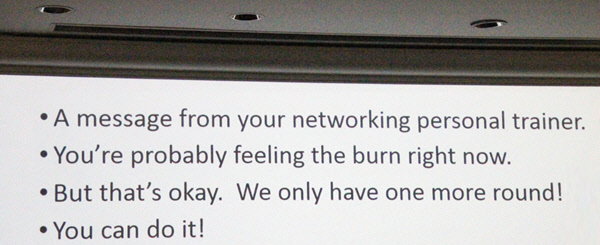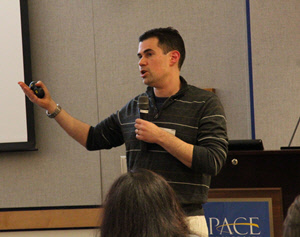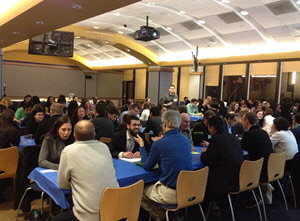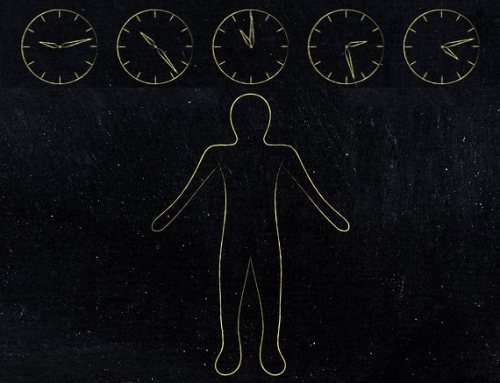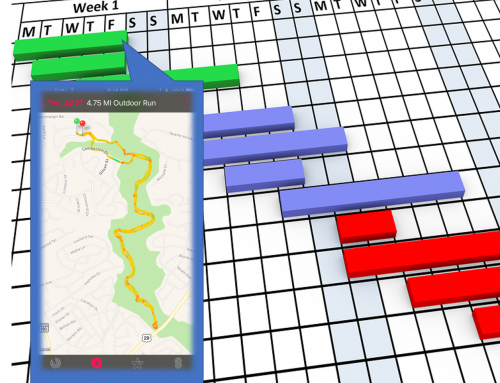In early November 2010, I was finishing up my first year as the president of the UXPA DC chapter and was in San Antonio on a separate user research project with the then UXPA DC VP, Jen Romano Bergstrom. One evening, after the research had ended for the day, we were chatting and brainstorming about UXPA DC upcoming events and started talking about whether we could pull off a UX speed networking event for the DC chapter. We decided that while we had an incredible chapter in and of itself, the most amazing networking value would come from giving people who attend all different types of UX organizations the opportunity to speed network together.
We quickly refined the plan, pulled in a number of local “sister” organizations, including both those that were local chapters of larger organizations and those that were DC-local independent Meetups, and had our first speed networking event at the end of the month. That event was an incredible success and was followed by subsequent events in July 2011 and then March and September of 2012. Each of the speed networking events attracted 80 – 100 participants.
A New Framework
A short time after the last of those four speed networking events, while I found that I had a large amount of work slated for 2013, I felt like I was missing something but couldn’t quite articulate it. I puzzled over this for a while and eventually came up with what I called a “UX Adventure” framework. I blogged about this in November 2012 and by March 2013, I had an article about UX Adventure in UX Magazine, further articulating this framework. About the same time, I had an article on networking within the UX community published in UXPA’s User Experience Magazine. A few months later I had an article published on The Value of UX organizations, again in UX Magazine. I realized that while these three articles were all on different topics, they all had a similar message: advance your UX career beyond job skills.
Pulling it all together into a talk
In October 2013, I was about to attend a conference in San Diego. Trying to make good use of my time, I contacted the SandCHI chapter, which was fairly local to the conference location, and asked them if they’d like me to speak while I was out there. They said that they would be interested and I gave them a list of talks I already had, but I also asked them if they’d like to consider a new talk that I was thinking about that pulled together the ideas of the three aforementioned articles into a talk called “Web and UX skills only get you so far.” In short, the talk was about getting out there beyond one’s job and doing unpaid activities, in addition to networking within the larger UX community and also finding value in UX organizations. The goal of the talk was to discuss combining these skills and perspectives in a way that would help lead to career success.
Forty people in San Diego attended, and based on the feedback I got, the talk was a big success. Two weeks later, I did a repeat of this talk to another 50 people locally in DC for a combined two UX-oriented meetups, Web Content Mavens and DC Web Women. This time, it was followed by some informal networking at a local bar.
Talk + Speed Networking package
A few weeks later, I tried something new. I spoke in Cleveland to about 80 people and this time combined my “Web and UX skills only get you so far” talk with a further-refined version of the speed networking event that we did in DC. Again, the event was successful, so at the next available opportunity, I did another combined effort in NYC for the NYC UXPA and IxDA chapters. It was also very successful with about 90 attendees.
What’s next?
Looking for more opportunities to give this talk
Admittedly, this talk, particularly when combined with a speed networking event, is one of the talks that I enjoy most of all, particularly when I can present it to the UX community. I’d definitely like to find more opportunities to deliver the talk and the speed networking event.
Expanding beyond UX
While I come from the perspective of a UX professional, I wonder whether this idea can be translated into new markets within the wider tech community. While the “players” may be different, with different orgs, different hash tags when using social media, etc., the principles should be pretty similar. This is particularly true if first considering overlapping communities, such as other types of tech-oriented communities, or perhaps marketing professionals, among others.
Positive Feedback from the Talk
The Presentation
- “Interesting – liked hearing that the personal and professional should be melded rather than separated.”
- “Cory’s presentation was great. I liked that it was very simple ideas and slides – much easier to remember his key points.”
- “He gave us concrete examples (e.g. “elevator pitch” and “UX adventure”) to help us relate to the topic. He was very approachable too.”
- “He made some interesting points and showed some good examples of the necessity of putting yourself out there. Though it seems obvious, it’s good to hear it reinforced. I liked the exercise to come up with a brief intro-pitch.”
The Networking
- “That was worthwhile. A good practice that you don’t usually get. Scary and exhausting, but the fact that it was short kept it bearable and was important to experience.”
- “I liked that a structure was put in place to network. That way, even less-than-extroverts have a chance.
- “This was wonderful. Allowed me to do more networking in an hour than I’ve done in the last year. It would be great if this could happen every month or two months, even if it’s a smaller version of it. It would encourage a lot more interaction and provide easier networking opportunities for those who don’t take to it naturally on a regular basis.”
- “Overall, it was a pretty good way to meet a bunch of people without being trapped into any 1 conversation.”
- “That was one of the best exercises I’ve done at a meeting. It was not easy spending all that time talking about myself, but it was a great learning experience to keep tweaking my pitch again and again. The most interesting thing was how the pitch often turned into a 2-way conversation.”

